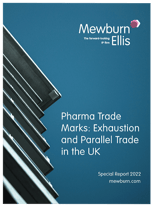
Towards the back end of last year, the Court of Justice of the European Union (CJEU) gave a series of landmark judgments concerning the parallel importation of pharmaceutical products.
In a recent article, we discussed the CJEU’s guidance on when brand owners can object to the repackaging of their pharmaceutical products by parallel importers within the EU.
The CJEU was also tasked with considering the question of when parallel importers can rebrand ‘generic’ medicinal products by applying the trade mark used on equivalent branded products (reference medicines). The judgment in Impexeco NV v Novartis AG and PI Pharma NV v Novartis AG (Joined cases C‑253/20 and C‑254/20) provides guidance on this point.
Background and issues
The cases involve the large pharmaceutical company Novartis, who sought to take action against Imprexco and PI Pharma, companies involved in the parallel importation of Novartis’ products.
The facts can be briefly summarised as follows:
- Novartis sold branded ‘reference’ medicines in the Netherlands and Belgium under the trade marks FEMARA and RETALIN/RITALINE. In the context of biosimilar and generic medicines, a reference medicine is the existing medicine already on the market that biosimilar and generic medicines are developed to be similar to or copies of respectively.
- Included within the Novartis Group is Sandoz, a pharmaceutical company which focuses on the production of generic medicines. Sandoz sold generic medicines in the Netherlands under the names ‘Letrozol Sandoz’ and ‘Methylphenidate HC1 Sandoz’.
- The Sandoz generic medicines, which contain the same active ingredients as the reference medicines sold by Novartis, were sold alongside the reference medicines, albeit at a lower price point.
- The parallel importers purchased the generic medicines sold by Sandoz in the Netherlands and marketed them in Belgium. However, before marketing, they rebranded them as FEMERA and RETALIN/RITALINE, the trade marks of the equivalent branded reference medicines sold by Novartis.
- Novartis claimed that rebranding their generic medicines by using the trade marks of their reference medicines was a manifest infringement of their trade mark rights, and so they sought injunctions.
- The parallel importers, on the other hand, argued that this rebranding was necessary in order for the products to be marketed in Belgium. As such, they claimed that Novartis should not be able to rely on their rights to stop these further dealings, as that would create an artificial partitioning of markets between Member States.
Novartis was successful at first instance, and it was found that the parallel importers had infringed their trade mark rights. This decision was then appealed. On appeal, the Brussels Court of Appeal referred several questions to the CJEU.
In essence, the key question to be determined can be summarised as follows: “can a trade mark proprietor who owns rights in both a reference medicinal product and a generic medicinal product prevent parallel imports of the generic products, where the generic products had been rebranded with the trade mark of the corresponding reference medicinal product?”
The decisions
In short, the CJEU answered this question with a resounding ‘yes’.
It was decided that the proprietor of trade marks for both reference and generic medicinal products could stop the parallel importation of generic products which have been rebranded as the corresponding reference product, unless both of the following criteria apply:
- The reference and generic medicines are identical in all respects.
The CJEU drew a distinction between medicines which are ‘therapeutically equivalent’ and medicines which are identical. In particular, it noted that reference and generic products can be therapeutically equivalent without necessarily being identical.
Medicines are likely to be considered to be identical in all respects where the reference medicine and the generic medicine are manufactured by the same entity or by economically linked entities, or where the medicines are in fact the same product which are sold under two different sets of rules.
In these cases, the Sandoz generic medicines were considered to be identical in all respects to the Novartis reference medicines, and so it was necessary to consider the second criteria.
- The replacement of the trade mark satisfies the conditions laid out in Bristol-Myers Squibb (Case C-427/93). These conditions are set out in full in our earlier article – available here.
The key question to examine here is whether the rebranding of generic medicines as reference medicines by the parallel importers is objectively necessary in order for the imported medicines to be marketed in the country of import.
On this point, the CJEU decided that where a parallel importer can market the generic medicinal product under its original name by adapting the packaging to satisfy the market requirements of the importing country, there is no objective "necessity" to rebrand. Furthermore, if the rebranding of the products is done only for an economic advantage, this is not objectively necessary.
In such a case, the brand owner would be allowed to enforce their rights to stop the rebranding of the generic medicines as the corresponding reference medicines.
Comment
It is hard to think of a situation where rebranding a generic medicine as a reference medicine will be considered to be “objectively necessary”. In almost every case, this will be done solely for economic advantage, to exploit the price differences between generic and branded medicines.
These decisions of the CJEU represent another clear win for the pharmaceutical brand owners. Going forward, it seems clear that parallel importers will not be able to repackage and rebrand generic pharmaceuticals as a branded reference medicine, even if the two medicines are identical.
The UK position
Rebecca Anderson-Smith, Mewburn Ellis Partner and Chartered Trade Mark Attorney, comments:
"Whilst this decision does not have direct affect in the UK, it is likely to be considered persuasive by a UK court hearing a similar case, and so it is unlikely we would see a marked deviation. For many years we have seen parallel importers consistently ‘push the limits’ of what they can do when it comes to repackaging and rebranding. However, laws on exhaustion and parallel importing were designed to encourage competition, not to give parallel traders free reign. It is therefore reassuring to see some boundaries being put in place to protect the interests of pharmaceutical trade mark owners.
A detailed analysis of the current law and practice on exhaustion and parallel trade in the context of pharmaceutical trade marks in the UK is available in our Special Report ‘Pharma Trade Marks: Exhaustion and Parallel Trade in the UK’."
Pharma Trade Marks: Exhaustion and Parallel Trade in the UK - Special Report 2022
In this special report we look at the complexities of the current trade mark exhaustion landscape, and the outcome of the recent UK government consultation (2021) on Exhaustion and Parallel Trade in the Pharmaceutical Sector.
Joe is an associate and a member of our trade mark team. He has an LLB Law degree from the University of Manchester and LLM in Professional Legal Practice from the University of Law, which encompassed the Legal Practice Course. At both undergraduate and postgraduate level, Joe completed modules on Intellectual Property law, which focussed on trade mark law and practice. Joe previously worked in the Business Crime and Regulation department at a solicitors’ firm on a high-profile criminal case.
Email: joe.mcalary@mewburn.com
Sign up to our newsletter: Forward - news, insights and features
Our people
Our IP specialists work at all stage of the IP life cycle and provide strategic advice about patent, trade mark and registered designs, as well as any IP-related disputes and legal and commercial requirements.
Our peopleContact Us
We have an easily-accessible office in central London, as well as a number of regional offices throughout the UK and an office in Munich, Germany. We’d love to hear from you, so please get in touch.
Get in touch



